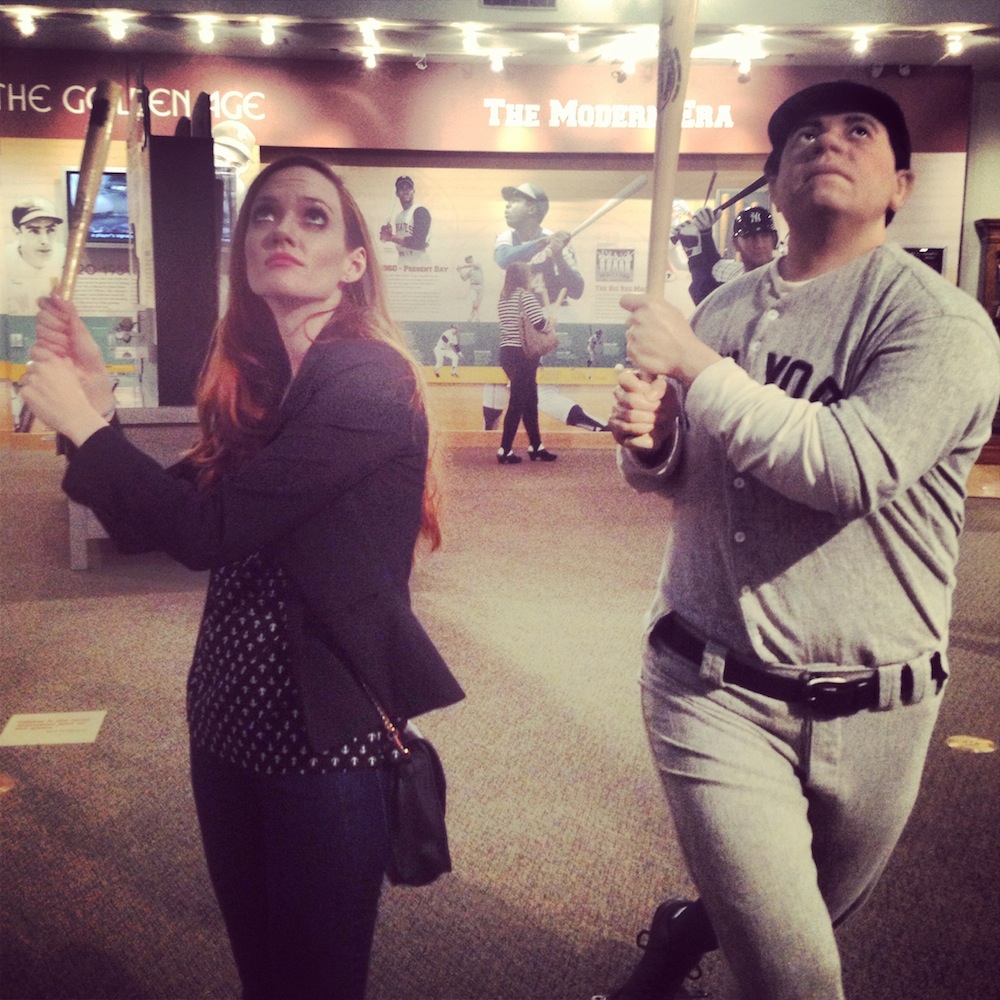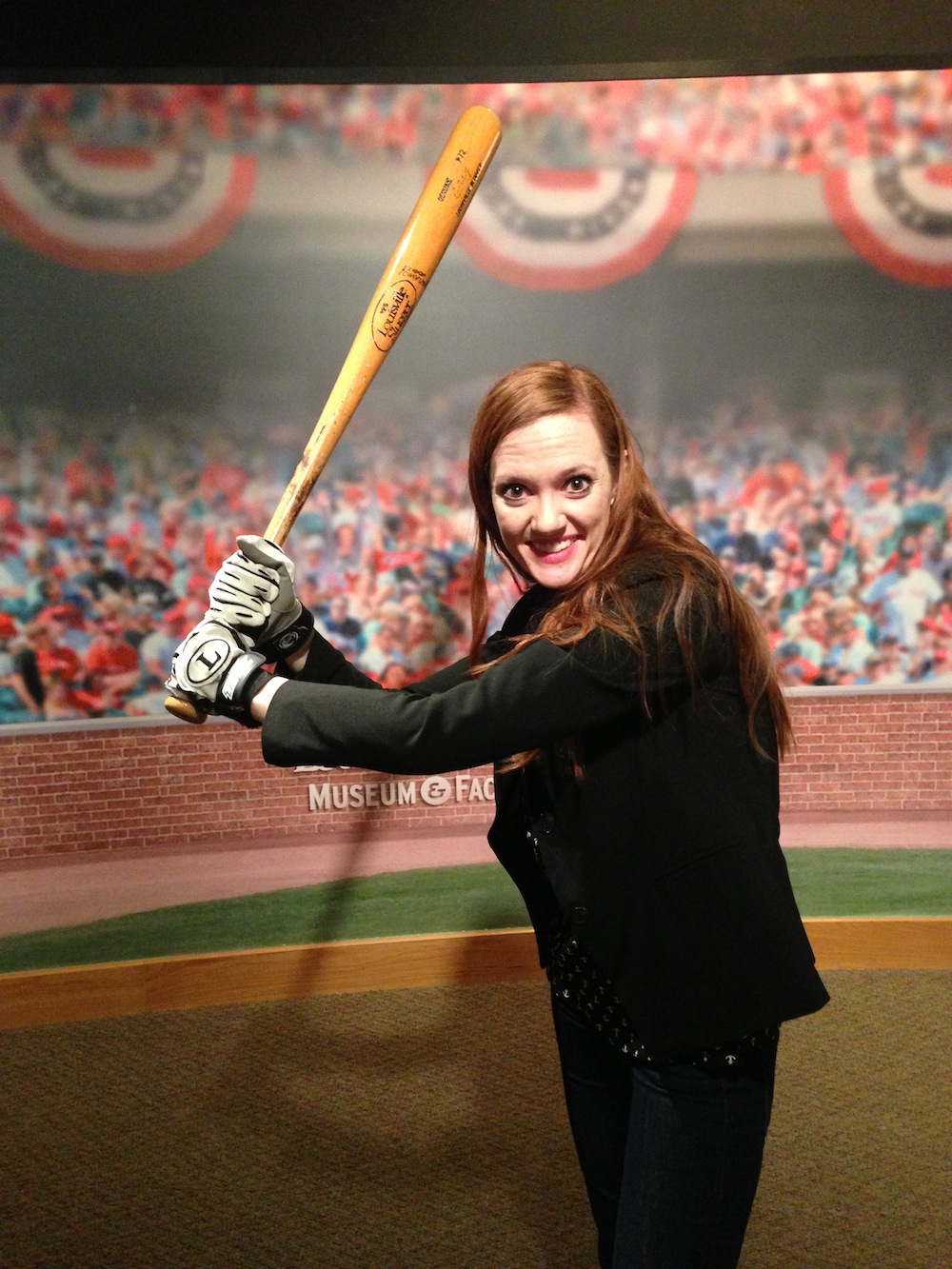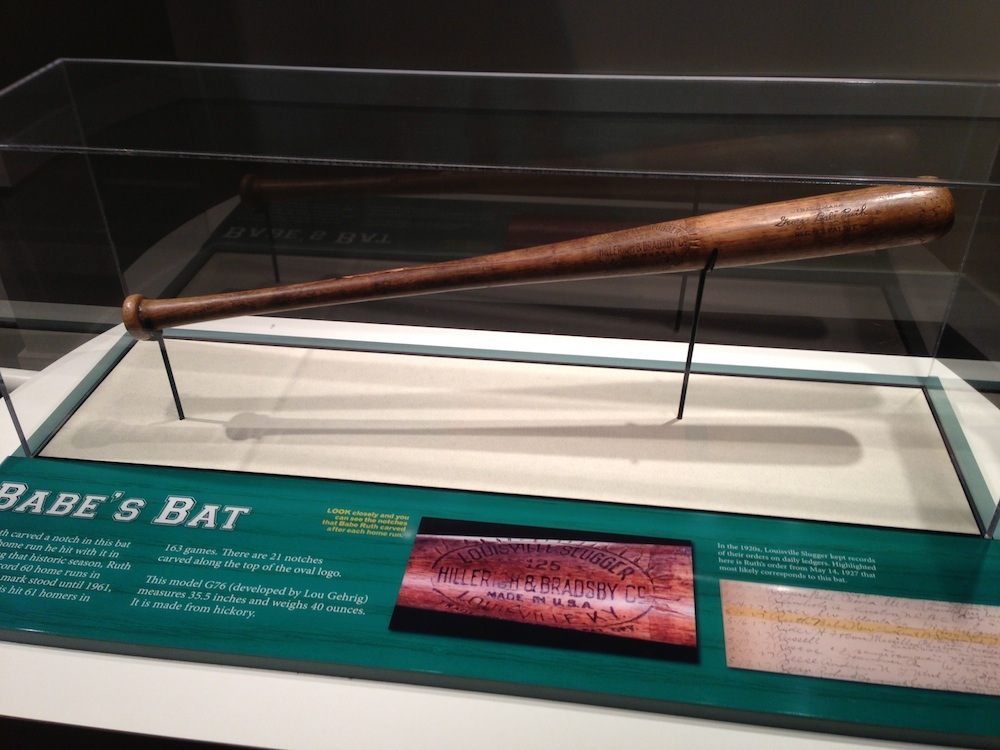I can hear peanut shells snapping and the bellowed out drawl of the umpire. I listen for the sound of the pitch and the crack of the bat. I can hear all of the elements for America’s pastime. Baseball is after all a game for the senses. My ears are burning for baseball and I’m not even in a stadium. I stand in the Louisville Slugger Museum in downtown Louisville, Kentucky surrounded by game winners, and losers, in the making.

Suzy, game loser. Babe Ruth, game winner
To some, the Louisville Slugger is merely a type of baseball bat. To others like me, it is the game of baseball. In Major League baseball, the Louisville Slugger bat is used by over 60% of all players. Composed of either northern white ash or maple, these baseball bats are the tools for the greatest of games.
“I don’t know how you did it folks, but you picked one of the best days to tour the factory,” my tour guide states. The Louisville Slugger Museum is not just a museum space, but also a working factory where the famous bat is produced. On the particular day that I grabbed a ticket, the factory just so happened to be in full production. Since 6 in the morning, countless artists and machines were turning logs into baseball bats for spring training.

Baseball bats are the limit here.
With no major league baseball team, Kentucky seems like an unlikely state to house the number one baseball bat producer of Major League Baseball. However Louisville can thank Bud Hillerich for starting the tradition. The Hillerich family of German immigrants came to Louisville and started a woodworking shop. The son, Bud, was an amateur baseball player. He would craft bats for his own use and for his teammates. Word quickly got out about his work.
Legend or reality, Bud is thought to have created the first Louisville Slugger for a professional ballplayer in 1884. While his father didn’t approve of the new focus of the wood-shop, the family business quickly morphed into the business of making baseball bats. Part of the appeal came as amateur baseball players could purchase the bat model of their favorite big leaguer. The Louisville Slugger brand is still all in the family, operated by Bud’s great grandson.
I take a tour of the museum and the factory, beginning with the chance to hold bats that were actually used by some of the game’s great hitters including Mickey Mantle and Cal Ripken Jr. Clearly my form is right in line with some of these greats.
Before entering the factory, I take in the experience of receiving a 90mph fastball from Cole Hamels. Needless to say I jumped every time. I also notice a number of notable bats including Babe Ruth’s Louisville Slugger. He carved notches in the bat for every homerun that he hit during the record setting 60-homerun season in 1927. You can almost hear the choir of baseball angels singing about this slugger.
After basking in the bats and lifelike sculptures of some of baseball’s past and present stars, I am motioned into the factory for my tour. This is the reason why I came, to see the bats that can create unending emotion in fans, players and coaches, come to fruition. I watch a bat demonstration, showing how Bud used to make the bats by hand in about 30 minutes. Now they can churn out bats in a matter of seconds.
On white boards in front of the machines turning logs into baseball bats, a player’s name might be listed. Today, right before my eyes, the bats of Ben Revere from the Phillies are being made. Suddenly this game isn’t so far away. I’m not disconnected from it. I’m surrounded by the bare bones that make those players succeed.
Once we exit the factory after observing all of the steps of the process from your basic log to imprinting the famous Louisville Slugger text onto the bat, I experience the site’s batting cages and giant art. Within the museum, a giant baseball glove, handcrafted from Kentucky limestone and weighing in at 17 tons plops down on the floor. And this isn’t even the museum’s grandest sculpture.
Outside the doors, you can’t miss the museum for its world’s biggest bat. Composed of steel, the bat leans against the building, all 68,000 pounds of it. Measuring 120 feet tall, it is the exact scale replica of Babe Ruth’s 34-inch Louisville Slugger. You can’t help but try to hug the thing, if only you could get your arms around the masterpiece.
After a visit to the Louisville Slugger Museum with my free souvenir bat in hand, I now know that the scents and sounds of baseball aren’t merely of Cracker Jack popping and the ball meeting the glove. Baseball in Kentucky sounds and smells much like I imagine a woodshop does. Freshly cut wood and confetti like chips are baseball in their simplest and most pure forms. They are the prospects of homeruns and game winners. And perhaps no other place in this sport lends so much promise and hope.
Have you been to the Louisville Slugger Museum?
Practicalities: Adult tickets to the museum and factory cost $11. You can’t take photographs in the factory but the museum exhibits are fair game.






Great article Suzy! This museum is an absolute must for any baseball fan. Can’t wait for the season to start!
It looks like you had a great time at the museum and certainly look to be getting into the spirit in those pictures.
When I’ve visited the US I’ve been to a few baseball games, mostly Atlanta Braves. I’ve learnt to appreciate some of the intricacies of the game yet somehow I just don’t have anywhere near the same level of passion that you Americans do.
Great post! I work as a tour guide in DC and I had a group of kids from just outside of Louisville. They gave me a mini Louisville slugger at the end of our 3 days together as a thank you. Fun to know the history!
Gotta say it wouldn’t have been my first choice in stops but now that I see the fun to be had there… you’ve changed my mind. Love the suspended bats!
Being from Philadelphia, I love all the Phillies player references! I hope to visit this museum someday.